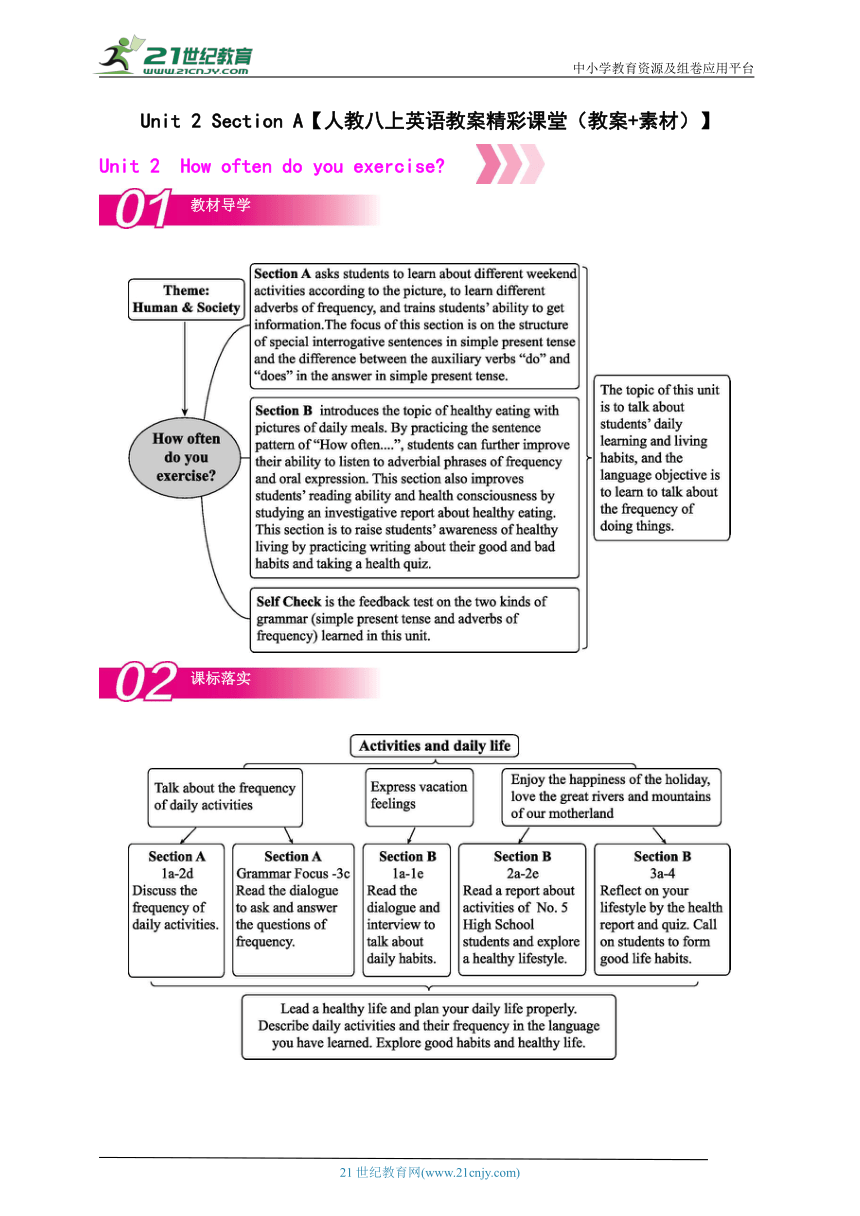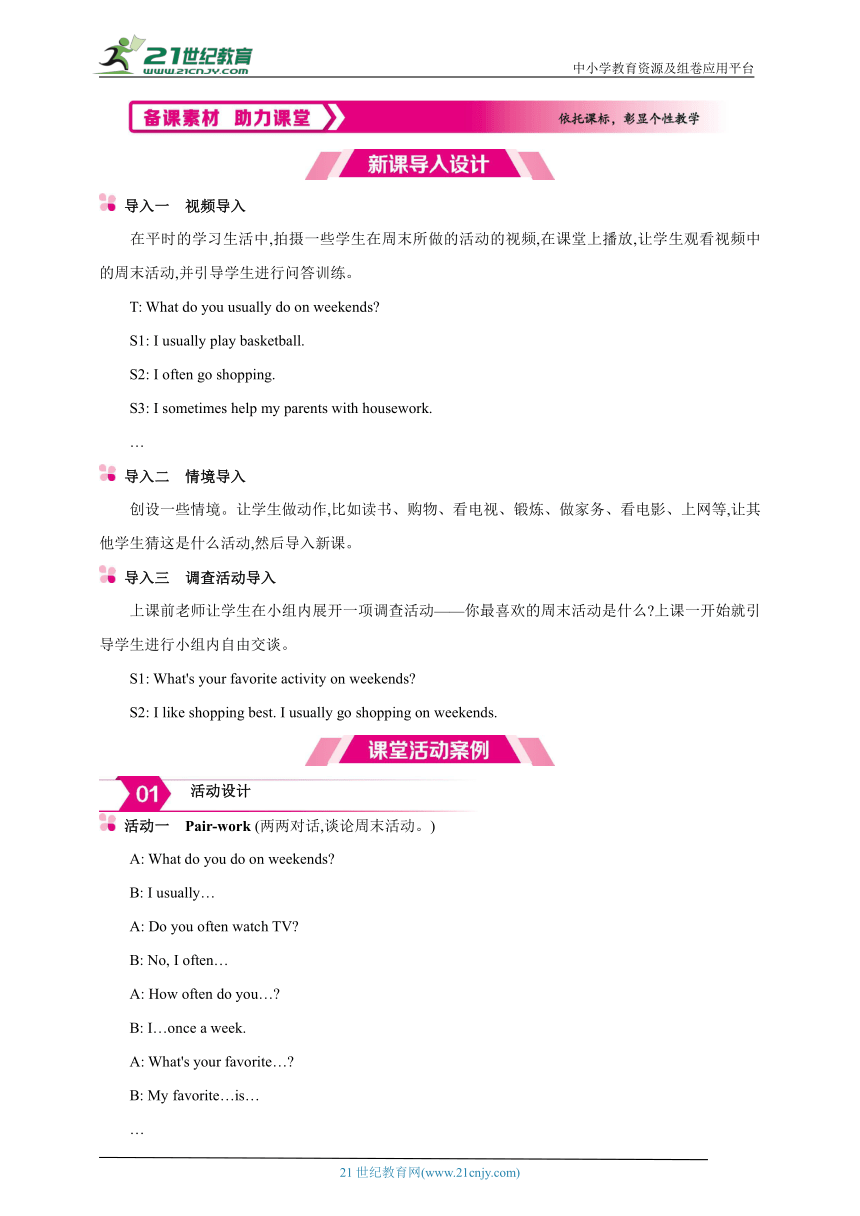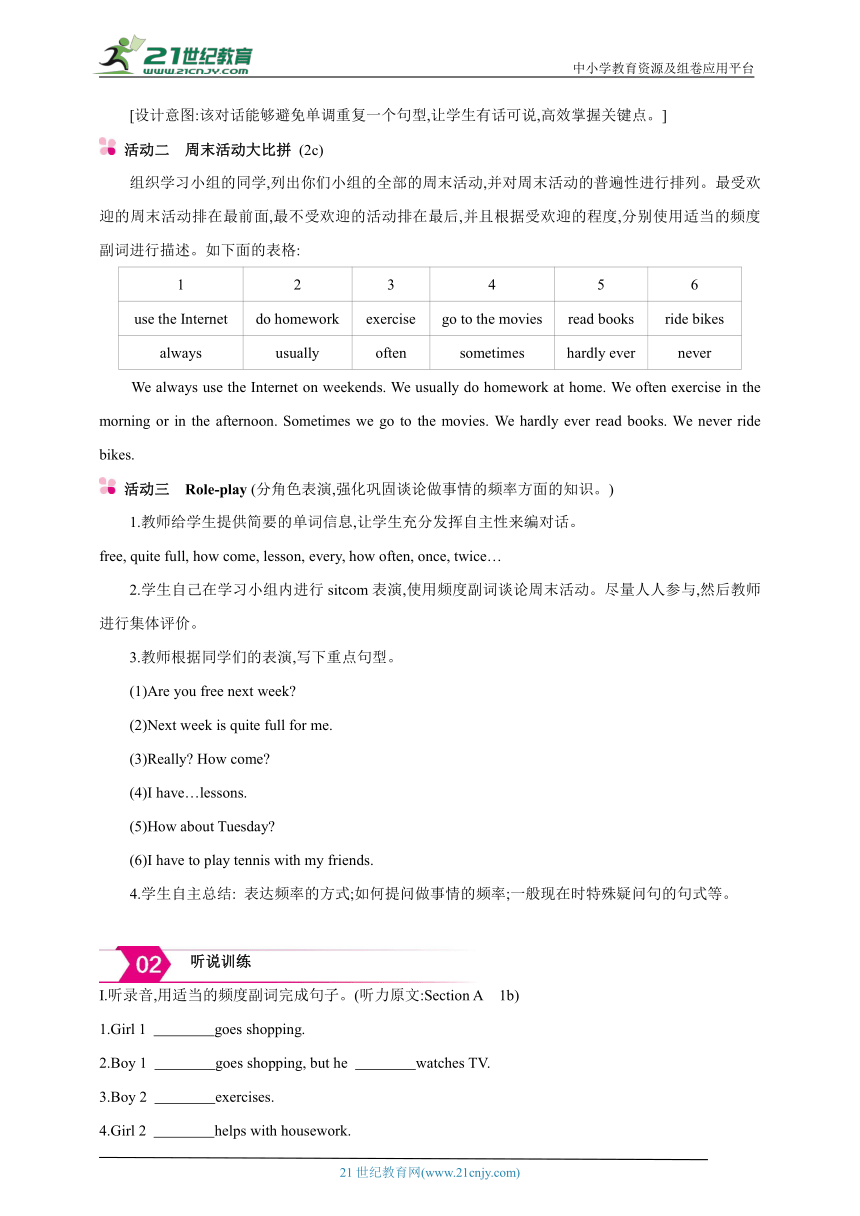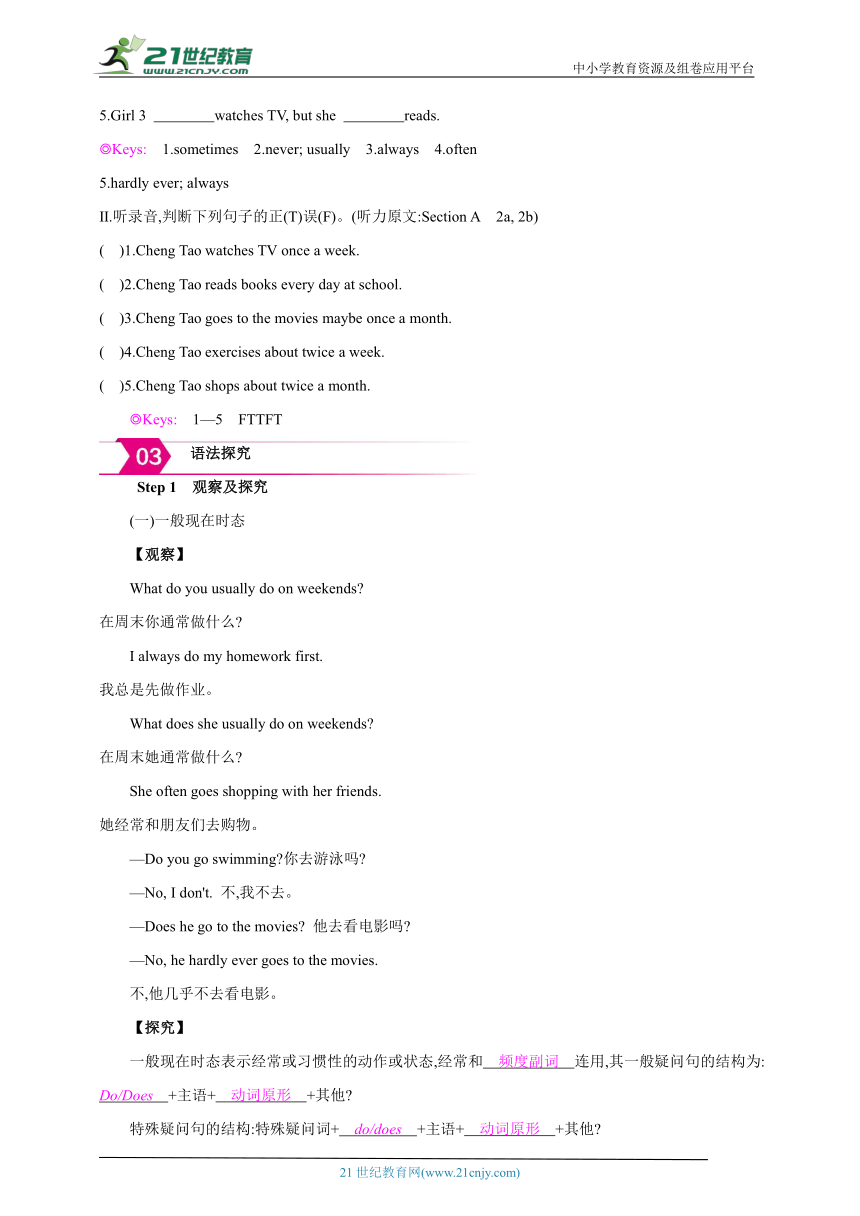Unit 2 How often do you exercise? Section A【人教八上英语教案精彩课堂(教案+素材)】
文档属性
| 名称 | Unit 2 How often do you exercise? Section A【人教八上英语教案精彩课堂(教案+素材)】 |  | |
| 格式 | docx | ||
| 文件大小 | 904.1KB | ||
| 资源类型 | 试卷 | ||
| 版本资源 | 人教新目标(Go for it)版 | ||
| 科目 | 英语 | ||
| 更新时间 | 2024-09-02 11:27:36 | ||
图片预览





文档简介
中小学教育资源及组卷应用平台
Unit 2 Section A【人教八上英语教案精彩课堂(教案+素材)】
Unit 2 How often do you exercise
教材导学
课标落实
导入一 视频导入
在平时的学习生活中,拍摄一些学生在周末所做的活动的视频,在课堂上播放,让学生观看视频中的周末活动,并引导学生进行问答训练。
T: What do you usually do on weekends
S1: I usually play basketball.
S2: I often go shopping.
S3: I sometimes help my parents with housework.
…
导入二 情境导入
创设一些情境。让学生做动作,比如读书、购物、看电视、锻炼、做家务、看电影、上网等,让其他学生猜这是什么活动,然后导入新课。
导入三 调查活动导入
上课前老师让学生在小组内展开一项调查活动——你最喜欢的周末活动是什么 上课一开始就引导学生进行小组内自由交谈。
S1: What's your favorite activity on weekends
S2: I like shopping best. I usually go shopping on weekends.
活动设计
活动一 Pair-work (两两对话,谈论周末活动。)
A: What do you do on weekends
B: I usually…
A: Do you often watch TV
B: No, I often…
A: How often do you…
B: I…once a week.
A: What's your favorite…
B: My favorite…is…
…
[设计意图:该对话能够避免单调重复一个句型,让学生有话可说,高效掌握关键点。]
活动二 周末活动大比拼 (2c)
组织学习小组的同学,列出你们小组的全部的周末活动,并对周末活动的普遍性进行排列。最受欢迎的周末活动排在最前面,最不受欢迎的活动排在最后,并且根据受欢迎的程度,分别使用适当的频度副词进行描述。如下面的表格:
1 2 3 4 5 6
use the Internet do homework exercise go to the movies read books ride bikes
always usually often sometimes hardly ever never
We always use the Internet on weekends. We usually do homework at home. We often exercise in the morning or in the afternoon. Sometimes we go to the movies. We hardly ever read books. We never ride bikes.
活动三 Role-play (分角色表演,强化巩固谈论做事情的频率方面的知识。)
1.教师给学生提供简要的单词信息,让学生充分发挥自主性来编对话。
free, quite full, how come, lesson, every, how often, once, twice…
2.学生自己在学习小组内进行sitcom表演,使用频度副词谈论周末活动。尽量人人参与,然后教师进行集体评价。
3.教师根据同学们的表演,写下重点句型。
(1)Are you free next week
(2)Next week is quite full for me.
(3)Really How come
(4)I have…lessons.
(5)How about Tuesday
(6)I have to play tennis with my friends.
4.学生自主总结: 表达频率的方式;如何提问做事情的频率;一般现在时特殊疑问句的句式等。
听说训练
Ⅰ.听录音,用适当的频度副词完成句子。(听力原文:Section A 1b)
1.Girl 1 goes shopping.
2.Boy 1 goes shopping, but he watches TV.
3.Boy 2 exercises.
4.Girl 2 helps with housework.
5.Girl 3 watches TV, but she reads.
◎Keys: 1.sometimes 2.never; usually 3.always 4.often
5.hardly ever; always
Ⅱ.听录音,判断下列句子的正(T)误(F)。(听力原文:Section A 2a, 2b)
( )1.Cheng Tao watches TV once a week.
( )2.Cheng Tao reads books every day at school.
( )3.Cheng Tao goes to the movies maybe once a month.
( )4.Cheng Tao exercises about twice a week.
( )5.Cheng Tao shops about twice a month.
◎Keys: 1—5 FTTFT
语法探究
Step 1 观察及探究
(一)一般现在时态
【观察】
What do you usually do on weekends
在周末你通常做什么
I always do my homework first.
我总是先做作业。
What does she usually do on weekends
在周末她通常做什么
She often goes shopping with her friends.
她经常和朋友们去购物。
—Do you go swimming 你去游泳吗
—No, I don't. 不,我不去。
—Does he go to the movies 他去看电影吗
—No, he hardly ever goes to the movies.
不,他几乎不去看电影。
【探究】
一般现在时态表示经常或习惯性的动作或状态,经常和 频度副词 连用,其一般疑问句的结构为: Do/Does +主语+ 动词原形 +其他
特殊疑问句的结构:特殊疑问词+ do/does +主语+ 动词原形 +其他
(二)频率的表示方法
【观察】
He exercises after school every day. 每天放学后他都锻炼。
He always helps with housework. 他总是帮忙做家务。
She goes shopping twice a month. 她一个月购物两次。
【探究】
频率表示单位时间内动作重复的次数,通常有以下三种表示方法:
1.使用every短语: every day/week/month/year…
2.使用频度副词: always, usually, often, sometimes, hardly ever, never。
3.使用短语“次数+时间段”,如: once a week, twice a month, three times ayear等。
语法巧记口诀:
一般现在时态
肯定句的现在时,不是三单就是原形,
三单就加-s, -es,若是否定疑问句,
没有be就加do,碰到三单加does;
若把does加在前,动词就要还原形。
Step 2 练习巩固 (教材P11 3a, 3b, 3c)
Section A
第一课时(1a-2d)
Study of the Text
What: This lesson is a daily conversation about the frequency of some activities. Activities 1a-1c focus on the weekend activities and the study and training of common adverbs of frequency. In 2a-2d, while practicing listening and speaking skills, students learn expressions of frequency and “How often… ” questioning and responding.
Why: Use “What can we do on the weekend ” as a trigger to activate students' background knowledge. The teacher should guide students to pay attention to the placement of the adverb of frequency in the sentence.
How: The lesson shows the target language by listening to conversations about the topic and promotes students to practice by chatting with classmates so that they can have a good command of this topic.Organize an oral report to evaluate how well students internalize what they have learned.
Teaching Objectives
1.To have a basic learning about simple present tense.
2.To master adverbs of frequency: always, usually, often, sometimes, hardly ever, never.
3.To learn to understand and use wh-questions: “What do… ” and “How often… ”.
Teaching Process
Teaching Objectives Teaching Activities Effectiveness Evaluation
1.To have a basic learning about simple present tense. 2.To master adverbs of frequency: always, usually, often, some-times, hardly ever, never. Step 1 Lead-in Show some pictures and ask students, “What does he or she usually do on weekends ” Step 2 Writing (1a) 1.Look at the picture. Discuss with your partner. Make a list of the weekend activities. 2.Let some students read out these activities. Let other students add more activities. Step 3 Listening (1b) 1.Let a student read the words aloud. Make sure all the students know the meaning of the words. 2.Play the audio for the first time. Students listen to it and fill in the blanks. 3.Play the audio for the second time. Ask the students to check their answers. Step 4 Practice Show the students the frequency words by pictures and the difference between them. Observe whether students can give the right answers and learn about students' vocabulary about weekend activities. Encourage students to communicate and express themselves bravely.
Purpose Simple present tense and adverbs of frequency are helpful for students to express their habits. The process of listening can improve students' ability to find out and summarize information.
3.To learn to understand and use wh-questions: “What do… ” and “How often… ”. Step 5 Pair-work (1c) 1.Act out the conversation with a partner. 2.Let students talk about the picture in pairs. 3.Ask students to make their own conversations about what they do on weekends. 4.Let some students act out their own conversations. Step 6 Work on 2a&2b: 1.Tell students to listen to the recording and number the activities in the order they hear them. 2.Listen to the recording for the second time. Match the activities in 2a with how often Cheng Tao does them. 3.Check the answers. 4.Analyze “once” “twice” and “how-” questions. Step 7 Role-play Work on 2c: 1.Ask one student how often he or she watches TV. 2.Let one student read the activities in the chart. Then ask some pairs of students to act out their conversations. Work on 2d: 1.Role-play the conversation. 2.Students work with a partner and practice the conversation. Then let some pairs of students act out the conversation in front of the class. Evaluate students' mastery of adverbs of frequency from their completed conversations. Pay attention to whether students cover the target language from the dialogues they present, and give students necessary guidance.
Purpose To give students the opportunity to use the target language.
Homework: 1.Required: To recite the key points learned in this unit. 2.Optional: To tell your activities and how often you do them to your classmates.
Teaching Reflection
第二课时(Grammar Focus-3c)
Study of the Text
What: Grammar Focus utilizes a table form to sort out the key points of grammar for the unit.Activities 3a-3c guide students to further appreciate, use and consolidate the target language.
Why: Activity 3a requires students to determine the type of question and to capture key information. This is an exercise that focuses on language structure.3b focuses on “How often…/What…usually do on weekends ” by having students write question sentences using the given words. 3c translates written training into oral training that allows students to synthesize the language they have learned.
How: Students can have a good command of the grammar by completing conversations, writing questions and communicating with classmates.
Teaching Objectives
1.To learn to ask and answer wh-questions “How often… ”.
2.To learn the usage of adverbs of frequency.
3.To write a report.
Teaching Process
Teaching Objectives Teaching Activities Effectiveness Evaluation
1.To learn to ask and answer wh-questions “How often… ”. Step 1 Presentation 1.Show the questions and answers in the Grammar Focus chart. 2.Do a report about the weekend activities in groups. Ask and answer some questions like “what does sb. do…” and “how often…”. Step 2 Grammar Focus 1.Show the conception, use and the way to pose question of frequency words. 2.Give the students five minutes to highlight the adverbs of frequency and question words. Learn roughly about students' language level and whether they can express themselves fluently and correctly.
Purpose To lead students to have a basic command of how to ask the frequency of activities.
2.To learn the usage of adverbs of frequency. Step 3 Work on 3a 1.Complete the questions with do or does. 2.Match the questions and answers. 3.Add some expressions used in the questions and answers. Step 4 Work on 3b 1.Use the words given to write questions. 2.Let students ask and answer the written questions with a partner. Ask students to show their questions and answers to the whole class. 3.Ask the same questions and invite students to repeat their answers in the third person. The teacher observes students completing the matching activity and provides guidance and feedback based on students' performance. Praise students for their good work and encourage them to use the expressions by themselves.
Purpose To improve students' ability to communicate and grasp information.
3.To write a report. Step 5 Do a Report 1.Ask students to add more things about improving their English. 2.Ask students to do a report and ask questions to interview their classmates. What can you do to improve your English How often do you… 3.Invite 2—3 students to give a report about their interviews. Step 6 Summary Make a summary about the use of adverbs of frequency. The teacher observes students' debriefing and evaluates the effectiveness of teaching and learning.
Purpose To achieve teaching objectives and knowledge application.
Homework: 1.Required: To recite the key points and sentences in this lesson. 2.Optional: To ask your friend about the frequency of their activities.
Teaching Reflection
21世纪教育网 www.21cnjy.com 精品试卷·第 2 页 (共 2 页)
21世纪教育网(www.21cnjy.com)
Unit 2 Section A【人教八上英语教案精彩课堂(教案+素材)】
Unit 2 How often do you exercise
教材导学
课标落实
导入一 视频导入
在平时的学习生活中,拍摄一些学生在周末所做的活动的视频,在课堂上播放,让学生观看视频中的周末活动,并引导学生进行问答训练。
T: What do you usually do on weekends
S1: I usually play basketball.
S2: I often go shopping.
S3: I sometimes help my parents with housework.
…
导入二 情境导入
创设一些情境。让学生做动作,比如读书、购物、看电视、锻炼、做家务、看电影、上网等,让其他学生猜这是什么活动,然后导入新课。
导入三 调查活动导入
上课前老师让学生在小组内展开一项调查活动——你最喜欢的周末活动是什么 上课一开始就引导学生进行小组内自由交谈。
S1: What's your favorite activity on weekends
S2: I like shopping best. I usually go shopping on weekends.
活动设计
活动一 Pair-work (两两对话,谈论周末活动。)
A: What do you do on weekends
B: I usually…
A: Do you often watch TV
B: No, I often…
A: How often do you…
B: I…once a week.
A: What's your favorite…
B: My favorite…is…
…
[设计意图:该对话能够避免单调重复一个句型,让学生有话可说,高效掌握关键点。]
活动二 周末活动大比拼 (2c)
组织学习小组的同学,列出你们小组的全部的周末活动,并对周末活动的普遍性进行排列。最受欢迎的周末活动排在最前面,最不受欢迎的活动排在最后,并且根据受欢迎的程度,分别使用适当的频度副词进行描述。如下面的表格:
1 2 3 4 5 6
use the Internet do homework exercise go to the movies read books ride bikes
always usually often sometimes hardly ever never
We always use the Internet on weekends. We usually do homework at home. We often exercise in the morning or in the afternoon. Sometimes we go to the movies. We hardly ever read books. We never ride bikes.
活动三 Role-play (分角色表演,强化巩固谈论做事情的频率方面的知识。)
1.教师给学生提供简要的单词信息,让学生充分发挥自主性来编对话。
free, quite full, how come, lesson, every, how often, once, twice…
2.学生自己在学习小组内进行sitcom表演,使用频度副词谈论周末活动。尽量人人参与,然后教师进行集体评价。
3.教师根据同学们的表演,写下重点句型。
(1)Are you free next week
(2)Next week is quite full for me.
(3)Really How come
(4)I have…lessons.
(5)How about Tuesday
(6)I have to play tennis with my friends.
4.学生自主总结: 表达频率的方式;如何提问做事情的频率;一般现在时特殊疑问句的句式等。
听说训练
Ⅰ.听录音,用适当的频度副词完成句子。(听力原文:Section A 1b)
1.Girl 1 goes shopping.
2.Boy 1 goes shopping, but he watches TV.
3.Boy 2 exercises.
4.Girl 2 helps with housework.
5.Girl 3 watches TV, but she reads.
◎Keys: 1.sometimes 2.never; usually 3.always 4.often
5.hardly ever; always
Ⅱ.听录音,判断下列句子的正(T)误(F)。(听力原文:Section A 2a, 2b)
( )1.Cheng Tao watches TV once a week.
( )2.Cheng Tao reads books every day at school.
( )3.Cheng Tao goes to the movies maybe once a month.
( )4.Cheng Tao exercises about twice a week.
( )5.Cheng Tao shops about twice a month.
◎Keys: 1—5 FTTFT
语法探究
Step 1 观察及探究
(一)一般现在时态
【观察】
What do you usually do on weekends
在周末你通常做什么
I always do my homework first.
我总是先做作业。
What does she usually do on weekends
在周末她通常做什么
She often goes shopping with her friends.
她经常和朋友们去购物。
—Do you go swimming 你去游泳吗
—No, I don't. 不,我不去。
—Does he go to the movies 他去看电影吗
—No, he hardly ever goes to the movies.
不,他几乎不去看电影。
【探究】
一般现在时态表示经常或习惯性的动作或状态,经常和 频度副词 连用,其一般疑问句的结构为: Do/Does +主语+ 动词原形 +其他
特殊疑问句的结构:特殊疑问词+ do/does +主语+ 动词原形 +其他
(二)频率的表示方法
【观察】
He exercises after school every day. 每天放学后他都锻炼。
He always helps with housework. 他总是帮忙做家务。
She goes shopping twice a month. 她一个月购物两次。
【探究】
频率表示单位时间内动作重复的次数,通常有以下三种表示方法:
1.使用every短语: every day/week/month/year…
2.使用频度副词: always, usually, often, sometimes, hardly ever, never。
3.使用短语“次数+时间段”,如: once a week, twice a month, three times ayear等。
语法巧记口诀:
一般现在时态
肯定句的现在时,不是三单就是原形,
三单就加-s, -es,若是否定疑问句,
没有be就加do,碰到三单加does;
若把does加在前,动词就要还原形。
Step 2 练习巩固 (教材P11 3a, 3b, 3c)
Section A
第一课时(1a-2d)
Study of the Text
What: This lesson is a daily conversation about the frequency of some activities. Activities 1a-1c focus on the weekend activities and the study and training of common adverbs of frequency. In 2a-2d, while practicing listening and speaking skills, students learn expressions of frequency and “How often… ” questioning and responding.
Why: Use “What can we do on the weekend ” as a trigger to activate students' background knowledge. The teacher should guide students to pay attention to the placement of the adverb of frequency in the sentence.
How: The lesson shows the target language by listening to conversations about the topic and promotes students to practice by chatting with classmates so that they can have a good command of this topic.Organize an oral report to evaluate how well students internalize what they have learned.
Teaching Objectives
1.To have a basic learning about simple present tense.
2.To master adverbs of frequency: always, usually, often, sometimes, hardly ever, never.
3.To learn to understand and use wh-questions: “What do… ” and “How often… ”.
Teaching Process
Teaching Objectives Teaching Activities Effectiveness Evaluation
1.To have a basic learning about simple present tense. 2.To master adverbs of frequency: always, usually, often, some-times, hardly ever, never. Step 1 Lead-in Show some pictures and ask students, “What does he or she usually do on weekends ” Step 2 Writing (1a) 1.Look at the picture. Discuss with your partner. Make a list of the weekend activities. 2.Let some students read out these activities. Let other students add more activities. Step 3 Listening (1b) 1.Let a student read the words aloud. Make sure all the students know the meaning of the words. 2.Play the audio for the first time. Students listen to it and fill in the blanks. 3.Play the audio for the second time. Ask the students to check their answers. Step 4 Practice Show the students the frequency words by pictures and the difference between them. Observe whether students can give the right answers and learn about students' vocabulary about weekend activities. Encourage students to communicate and express themselves bravely.
Purpose Simple present tense and adverbs of frequency are helpful for students to express their habits. The process of listening can improve students' ability to find out and summarize information.
3.To learn to understand and use wh-questions: “What do… ” and “How often… ”. Step 5 Pair-work (1c) 1.Act out the conversation with a partner. 2.Let students talk about the picture in pairs. 3.Ask students to make their own conversations about what they do on weekends. 4.Let some students act out their own conversations. Step 6 Work on 2a&2b: 1.Tell students to listen to the recording and number the activities in the order they hear them. 2.Listen to the recording for the second time. Match the activities in 2a with how often Cheng Tao does them. 3.Check the answers. 4.Analyze “once” “twice” and “how-” questions. Step 7 Role-play Work on 2c: 1.Ask one student how often he or she watches TV. 2.Let one student read the activities in the chart. Then ask some pairs of students to act out their conversations. Work on 2d: 1.Role-play the conversation. 2.Students work with a partner and practice the conversation. Then let some pairs of students act out the conversation in front of the class. Evaluate students' mastery of adverbs of frequency from their completed conversations. Pay attention to whether students cover the target language from the dialogues they present, and give students necessary guidance.
Purpose To give students the opportunity to use the target language.
Homework: 1.Required: To recite the key points learned in this unit. 2.Optional: To tell your activities and how often you do them to your classmates.
Teaching Reflection
第二课时(Grammar Focus-3c)
Study of the Text
What: Grammar Focus utilizes a table form to sort out the key points of grammar for the unit.Activities 3a-3c guide students to further appreciate, use and consolidate the target language.
Why: Activity 3a requires students to determine the type of question and to capture key information. This is an exercise that focuses on language structure.3b focuses on “How often…/What…usually do on weekends ” by having students write question sentences using the given words. 3c translates written training into oral training that allows students to synthesize the language they have learned.
How: Students can have a good command of the grammar by completing conversations, writing questions and communicating with classmates.
Teaching Objectives
1.To learn to ask and answer wh-questions “How often… ”.
2.To learn the usage of adverbs of frequency.
3.To write a report.
Teaching Process
Teaching Objectives Teaching Activities Effectiveness Evaluation
1.To learn to ask and answer wh-questions “How often… ”. Step 1 Presentation 1.Show the questions and answers in the Grammar Focus chart. 2.Do a report about the weekend activities in groups. Ask and answer some questions like “what does sb. do…” and “how often…”. Step 2 Grammar Focus 1.Show the conception, use and the way to pose question of frequency words. 2.Give the students five minutes to highlight the adverbs of frequency and question words. Learn roughly about students' language level and whether they can express themselves fluently and correctly.
Purpose To lead students to have a basic command of how to ask the frequency of activities.
2.To learn the usage of adverbs of frequency. Step 3 Work on 3a 1.Complete the questions with do or does. 2.Match the questions and answers. 3.Add some expressions used in the questions and answers. Step 4 Work on 3b 1.Use the words given to write questions. 2.Let students ask and answer the written questions with a partner. Ask students to show their questions and answers to the whole class. 3.Ask the same questions and invite students to repeat their answers in the third person. The teacher observes students completing the matching activity and provides guidance and feedback based on students' performance. Praise students for their good work and encourage them to use the expressions by themselves.
Purpose To improve students' ability to communicate and grasp information.
3.To write a report. Step 5 Do a Report 1.Ask students to add more things about improving their English. 2.Ask students to do a report and ask questions to interview their classmates. What can you do to improve your English How often do you… 3.Invite 2—3 students to give a report about their interviews. Step 6 Summary Make a summary about the use of adverbs of frequency. The teacher observes students' debriefing and evaluates the effectiveness of teaching and learning.
Purpose To achieve teaching objectives and knowledge application.
Homework: 1.Required: To recite the key points and sentences in this lesson. 2.Optional: To ask your friend about the frequency of their activities.
Teaching Reflection
21世纪教育网 www.21cnjy.com 精品试卷·第 2 页 (共 2 页)
21世纪教育网(www.21cnjy.com)
同课章节目录
- Unit 1 Where did you go on vacation?
- Section A
- Section B
- Unit 2 How often do you exercise?
- Section A
- Section B
- Unit 3 I'm more outgoing than my sister.
- Section A
- Section B
- Unit 4 What's the best movie theater?
- Section A
- Section B
- Unit 5 Do you want to watch a game show?
- Section A
- Section B
- Unit 6 I'm going to study computer science.
- Section A
- Section B
- Unit 7 Will people have robots?
- Section A
- Section B
- Unit 8 How do you make a banana milk shake?
- Section A
- Section B
- Unit 9 Can you come to my party?
- Section A
- Section B
- Unit 10 If you go to the party, you'll have a grea
- Section A
- Section B
